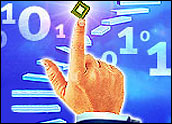
Now that IBM and Intel have both created chips using 45nm process technology, it’s clear chip technology will continue at least a little longer on the path predicted by Moore’s Law, with ever-tinier creations coming out every two years or so.
High-k metals, in particular, appear to help solve one of the biggest problems that have dogged chip designers and manufacturers in recent years: power leakage. While silicon historically has resulted in more and more heat loss as transistors got tinier and tinier, high-K metals used in transistor gate dielectrics appear to significantly reduce the problem.
The result? A win-win for both manufacturers and consumers. Transistors will continue shrinking, at least in the near term, and many of the devices that use them will begin exploding with functionality.
The Incredible Shrinking Geometry
“Geometries are shrinking,” Stephan Ohr, research director for analog semiconductors at Gartner Group, told TechNewsWorld. “We’re getting close to Angstrom, or atomic, levels. Right now a lot of work is being done at 65nm, and road maps take us down as far as 22nm. You can use this to build New York City on the head of a pin — and that’s barely an exaggeration.”
While the first integrated circuit was a 4-transistor device, Intel’s new generation of chips will have dual processing cores and 535 million transistors, Ohr pointed out.
“We’re looking in a couple years to put 16 to 32 processors on a single chip,” Jim McGregor, research director and principal analyst for In-Stat, told TechNewsWorld. “Imagine taking a rack of supercomputers and shrinking it down to the size of a PC. We face some roadblocks, but over the next 10 years the semiconductor industry will continue its march toward innovation. I don’t see that stopping.”
Of course, the goal is not to make devices themselves smaller, Ohr noted. Rather, it’s to pack more transistors into one consistently sized chip.
Same Space, More Functions
Essentially, when transistors get smaller, that means they occupy a smaller proportion of the space allotted to them. “You have an increased transistor budget,” Roger Kay, president of Endpoint Technologies, told TechNewsWorld. “So the question becomes, what can you do with that budget?”
What’s happening, Kay said, is that manufacturers can add more modules to the device in question, allowing it to increase its functionality without getting any bigger.
“What you get is increased performance at reduced cost,” McGregor explained. “We keep increasing the amount of stuff we can put on a single chip, and consumer electronics is the area with the biggest benefit.”
The Phone Factor
Cell phones, or smartphones, are one of the best examples. “As you get a higher transistor budget, your cell phone can also be an MP3 player, a personal information manager, a video player. We’re seeing a piling-on of functionality. Today, you can pretty much have whatever you want,” Kay stated.
“It’s like a cake,” he continued. “The cost is in the mixing and baking. If you can get more transistors in for the same mixing and baking, in some sense those are free transistors. Once you’ve spent money on design and intellectual property, the incremental cost is essentially zero.”
The limit, then, is just complexity — when there are too many functions, or too much for users to learn and get value from.
Who’s Speaking?
The addition of video capabilities to consumer devices is one Kay believes is widespread, and it’s already being seen in smartphones. Same with the addition of music capabilities. “Traditionally, music capabilities were too hot, too big and needed too many circuits,” said Kay.
Another more challenging addition is voice recognition, he added. “The best voice recognition software is very large, with lots of analysis modules. Being able to solve the voice problem well takes lots of transistors, and integrating it into a smaller device is a sort of a Holy Grail.”
The result, though, would enable cell phone users to use voice rather than key-pad commands to operate their device.
Home Consoles, Diet Advisors
“Where Intel wants to take this is home media consoles,” Ohr declared. In that scenario, your home PC becomes your telephone with VoIP, videoconferencing and multimedia, in addition to Internet access with shopping, browsing and e-mail.
More transistors, again, is what makes it possible.
Wearable computers are another realm Ohr sees being enabled by the increasingly tiny transistors. Among their capabilities might be monitoring of medical devices as well as the ability to read and interpret ingredients labels in the grocery store, for example. “The more transistors you have, the easier and speedier the decision is to automate,” he explained. The result could be assistance in deciding which products on the shelves best match with your particular diet.
Power Struggle
For the future, open questions include how to power all these capabilities. “The power consumption is not trivial,” Ohr pointed out. “Regulators in battery chargers are among the least efficient devices out there, but they are used because they’re the lowest cost.”
“Power consumption is a killer,” McGregor added. “A primary goal is reducing it. Battery technology is not keeping up with the rest of the technology, and that’s a critical challenge.”
Perhaps even more pressing, though, is the question of interoperability. “The biggest challenges rely not on silicon but on software,” McGregor claimed. “We don’t have the software to make things interoperable. Those are issues we need to start addressing with standards and a better software environment. We need to start thinking more holistically about interoperability and the fit to consumer needs.”
In short, the market is changing rapidly. Instead of technology pushing the market, consumers are pushing technology, McGregor said. In not too long, “we’re going to see this true convergence device that can do anything in the palm of your hand,” he added, “and whatever form factor you choose is up to you.”





















































